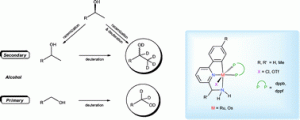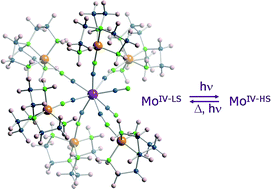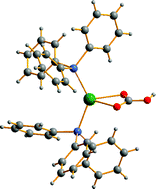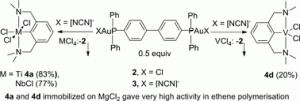 In this HOT article, the molecular structures of 1,2-closo-P2B10H10 (1) and 1,2-closo-As2B10H10 (2) have been determined by gas electron diffraction and the results obtained compared with those from computation at the MP2/6-31G** level of theory. The first examples of metalladiphosphaboranes and a considerable extension of the range of known metalladiarsaboranes, these compounds being prepared from deboronated derivatives of 1 and 2, respectively, are also reported.
In this HOT article, the molecular structures of 1,2-closo-P2B10H10 (1) and 1,2-closo-As2B10H10 (2) have been determined by gas electron diffraction and the results obtained compared with those from computation at the MP2/6-31G** level of theory. The first examples of metalladiphosphaboranes and a considerable extension of the range of known metalladiarsaboranes, these compounds being prepared from deboronated derivatives of 1 and 2, respectively, are also reported.
Read more for FREE about the structural chemistry of closo-heteroboranes in the gas-phase…. at:
New chemistry of 1,2-closo-P2B10H10 and 1,2-closo-As2B10H10; in silico and gas electron diffraction structures, and new metalladiphospha- and metalladiarsaboranes
R. McLellan, N. M. Boag, K. Dodds, D. Ellis, S. A. Macgregor, D. McKay, S. L. Masters, R. Noble-Eddy, N. P. Platt, D. W. H. Rankin, H. E. Robertson, G. M. Rosair and A. J. Welch
Dalton Trans., 2011, Advance Article
DOI: 10.1039/C1DT10540J















 In this HOT article, the authors have extended their work in understanding enantioselective catalysis by coordination compounds. The role of steric hindrance in controlling the binding mode of propylene oxide to a novel vanadyl salen-type complex N,N‘-bis(5-tert-butylsalicylidene)-1,2-cyclohexanediamino-vanadium(IV) oxide, [VO(3)], has been investigated using CW/pulse EPR, ENDOR and HYSCORE spectroscopy and compared to that of the parent complex N,N‘-bis(3,5-di-tert-butylsalicylidene)-1,2-cyclohexanediamino-vanadium(IV) oxide, [VO(1)]. Removal of the ‘inner tert-butyl groups from the salicylidene rings reduces the steric hindrance between the ligand and epoxide substrate. As a result the selectivity for binding single enantiomers of propylene oxide in these complexes is reversed in [VO(3)] relative to [VO(1)].
In this HOT article, the authors have extended their work in understanding enantioselective catalysis by coordination compounds. The role of steric hindrance in controlling the binding mode of propylene oxide to a novel vanadyl salen-type complex N,N‘-bis(5-tert-butylsalicylidene)-1,2-cyclohexanediamino-vanadium(IV) oxide, [VO(3)], has been investigated using CW/pulse EPR, ENDOR and HYSCORE spectroscopy and compared to that of the parent complex N,N‘-bis(3,5-di-tert-butylsalicylidene)-1,2-cyclohexanediamino-vanadium(IV) oxide, [VO(1)]. Removal of the ‘inner tert-butyl groups from the salicylidene rings reduces the steric hindrance between the ligand and epoxide substrate. As a result the selectivity for binding single enantiomers of propylene oxide in these complexes is reversed in [VO(3)] relative to [VO(1)]. In this HOT article, the molecular structures of 1,2-closo-P2B10H10 (1) and 1,2-closo-As2B10H10 (2) have been determined by gas electron diffraction and the results obtained compared with those from computation at the MP2/6-31G** level of theory. The first examples of metalladiphosphaboranes and a considerable extension of the range of known metalladiarsaboranes, these compounds being prepared from deboronated derivatives of 1 and 2, respectively, are also reported.
In this HOT article, the molecular structures of 1,2-closo-P2B10H10 (1) and 1,2-closo-As2B10H10 (2) have been determined by gas electron diffraction and the results obtained compared with those from computation at the MP2/6-31G** level of theory. The first examples of metalladiphosphaboranes and a considerable extension of the range of known metalladiarsaboranes, these compounds being prepared from deboronated derivatives of 1 and 2, respectively, are also reported. A N^N Pt(II) bis(acetylide) complex containing coumarin was prepared in this Dalton Transactions Hot article.
A N^N Pt(II) bis(acetylide) complex containing coumarin was prepared in this Dalton Transactions Hot article. The most stable crystal structures of different TCN compounds are investigated in this Dalton Transactions Hot article.
The most stable crystal structures of different TCN compounds are investigated in this Dalton Transactions Hot article. Rechargeable lithium-ion batteries (LIBs) have successfully dominated the commercial power supply market for advanced portable electronics. In this regard, metallic Sn has attracted a great deal of interest as an anode material because of its high theoretical capacity offering a significant advantage over the currently used graphite but until now has not been utilized due to the huge volumetric changes during Li-insertion/extraction cycling, which leads to rapid pulverization and poor cyclability of the materials.
Rechargeable lithium-ion batteries (LIBs) have successfully dominated the commercial power supply market for advanced portable electronics. In this regard, metallic Sn has attracted a great deal of interest as an anode material because of its high theoretical capacity offering a significant advantage over the currently used graphite but until now has not been utilized due to the huge volumetric changes during Li-insertion/extraction cycling, which leads to rapid pulverization and poor cyclability of the materials. 
